Chinese Journal of Tissue Engineering Research ›› 2013, Vol. 17 ›› Issue (18): 3349-3357.doi: 10.3969/j.issn.2095-4344.2013.18.017
Previous Articles Next Articles
Vascularized tissue-engineered adipose established via the adipose-derived stem cells-attached scaffolds encapsulated in muscular fasciae with axial pattern blood vessel pedicle
Wang He-geng1, Li Hong-mian1, Cui Shi-en2, Xu Kun-ming1
- 1 Department of Plastic and Aesthetic Surgery, Postdoctoral Mobile Work Station, the Affiliated Zhongshan Hospital of Sun Yat-sen University, Zhongshan 528403, Guangdong Province, China
2 Department of Mammary Gland Surgery, the Affiliated Zhongshan Hospital of Sun Yat-sen University, Zhongshan 528403, Guangdong Province, China
-
Received:2012-05-31Revised:2012-07-24Online:2013-04-30Published:2013-04-30 -
Contact:Li Hong-mian, Doctor, Chief physician, Master’s supervisor, Department of Plastic and Aesthetic Surgery, Postdoctoral Mobile Work Station, the Affiliated Zhongshan Hospital of Sun Yat-Sen University, Zhongshan 528403, Guangdong Province, China binrong2112@163.com -
About author:Wang He-geng★, Master, Associate chief physician, Department of Plastic and Aesthetic Surgery, the Affiliated Zhongshan Hospital of Sun Yat-Sen University, Zhongshan 528403, Guangdong Province, China drwanghegeng@126.com -
Supported by:China Postdoctoral Science Foundation, No. 20090450910; Guangdong Medical Scientific Foundation, No. A2011739; Zhongshan Scientific and Technological Planning Projects, No. 20113A008
CLC Number:
Cite this article
Wang He-geng1, Li Hong-mian1, Cui Shi-en2, Xu Kun-ming1. Vascularized tissue-engineered adipose established via the adipose-derived stem cells-attached scaffolds encapsulated in muscular fasciae with axial pattern blood vessel pedicle[J]. Chinese Journal of Tissue Engineering Research, 2013, 17(18): 3349-3357.
share this article
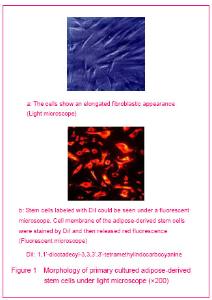
Quantitative analysis of experimental animals A total of 10 rabbits involved in the experiment at the beginning. No rabbit dead or got infection until the end of the experiment. Characterization of adipose-derived stem cells expanded ex vivo After primary cultured in the control medium, adipose-derived stem cells were harvested with an elongated fibroblast like appearance (Figure 1 a). After expanded to passages 3, the cells were detached and stained with fluorescent dye- 1,1'-dioctadecyl-3,3,3',3'-tetramethylindocarbocyanine (Figure 1 b). The 1,1’-dioctadecyl- 3,3,3',3'- tetramethylindocarbocyanine stained adipose-derived stem cells were selected for the experiment."
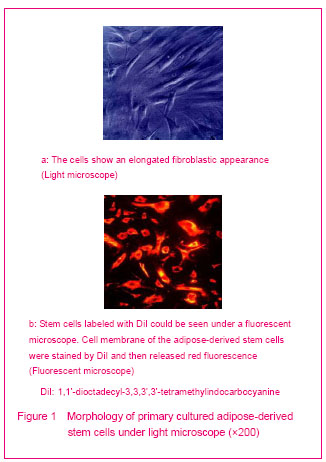
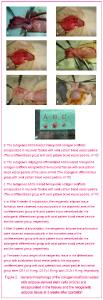
General observation and humid weight detection of neogenetic tissue The histological morphology of the tissues in each group is showed in Figures 2a-c. At 8 weeks after operation, the neogenetic adipose tissue formation was observed macroscopically in the operative area of differentiated group (Figures 2d, g), undifferentiated group (Figures 2e, g) and control group (Figures 2f, g). And then the hematoxylin-eosin staining showed that the neogenetic tissues were adipose tissues. The mean humid weight was (25.1±1.9) mg of the neogenetic tissue in the differentiated group was higher than that of the undifferentiated group (23.0±1.6) mg and the control group (20.2±1.4) mg (P < 0.01)."
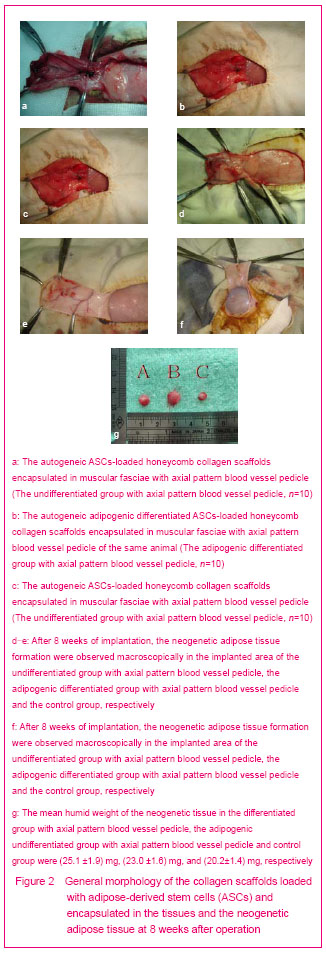
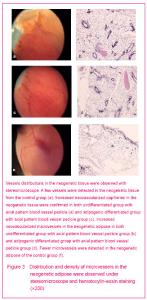
Vessel distribution observed with stereomicroscope Vessels could be seen in the undifferentiated group with axial pattern blood vessel pedicle (Figure 3a) and the differentiated group with axial pattern blood vessel pedicle (Figure 3c). The neogenetic capillaries were found in the undifferentiated group with axial pattern blood vessel pedicle (Figure 3b) and the differentiated group with axial pattern blood vessel pedicle (Figure 3d)."
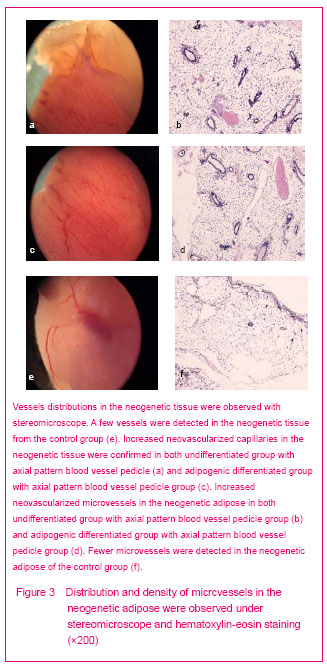
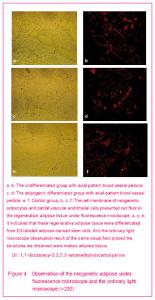
Histological changes of capillary in each group The scaffolds were degraded thoroughly after 8 weeks at the new formed tissue. Obvious difference could be found about the capillary density in different groups. Compared to the control group (Figure 3f), capillary density of the neogenetic adipose tissue was obviously increased in both the undifferentiated group with axial pattern blood vessel pedicle (Figure 3b) and the adipogenic differentiated group with axial pattern blood vessel pedicle (Figure 3d; P < 0.05). Histological evaluation of 20 fields of neogenetic adipose tissue showed that the mean number of capillaries per field, an index of neovascularization, in the undifferentiated group with axial pattern blood vessel pedicle was (28.5±4.6) capillaries and the adipogenic differentiated group with axial pattern blood vessel pedicle was (31.2±4.5) capillaries, which both had a statistically significant increase in capillary density compared with control group. And control group were (19.3±2.6) capillaries."
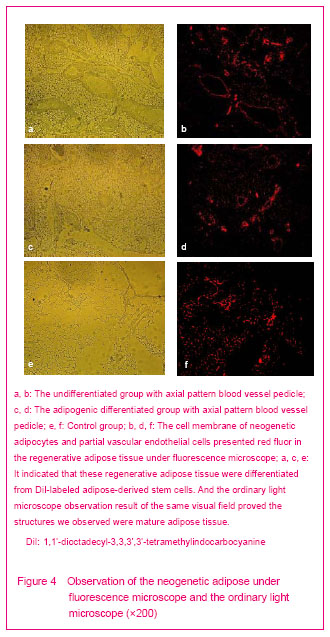
| [1] Asahara T, Masuda H, Takahashi T, et al. Bone marrow origin of endothelial progenitor cells responsible for postnatal vasculogenesis in physiological and pathological neovascularization. Circ Res. 1999;85(3):221-228.[2] Nakagami H, Maeda K, Morishita R, et al. Novel autologous cell therapy in ischemic limb disease through growth factor secretion by cultured adipose tissue-derived stromal cells. Arterioscler Thromb Vasc Biol. 2005;25(12): 2542-2547. [3] Planat-Benard V, Silvestre JS, Cousin B, et al. Plasticity of human adipose lineage cells toward endothelial cells: physiological and therapeutic perspectives. Circulation. 2004;109(5):656-663.[4] Boquest AC, Shahdadfar A, Brinchmann JE, et al. Isolation of stromal stem cells from human adipose tissue. Methods Mol Biol. 2006;325:35-46. [5] Boquest AC, Noer A, Collas P. Epigenetic programming of mesenchymal stem cells from human adipose tissue. Stem Cell Rev. 2006;2(4):319-329. [6] Kim Y, Kim H, Cho H, et al. Direct comparison of human mesenchymal stem cells derived from adipose tissues and bone marrow in mediating neovascularization in response to vascular ischemia. Cell Physiol Biochem. 2007;20(6): 867-876. [7] Lu F, Gao JH, Ogawa R, et al. Adipose tissues differentiated by adipose-derived stem cells harvested from transgenic mice. Chin J Traumatol. 2006;9(6):359-364. [8] Shi YY, Nacamuli RP, Salim A, et al. The osteogenic potential of adipose-derived mesenchymal cells is maintained with aging. Plast Reconstr Surg. 2005;116(6): 1686-1696. [9] Ogawa R, Mizuno H, Hyakusoku H, et al. Chondrogenic and osteogenic differentiation of adipose-derived stem cells isolated from GFP transgenic mice. J Nippon Med Sch. 2004;71(4):240-241. [10] Safford KM, Safford SD, Gimble JM, et al. Characterization of neuronal/glial differentiation of murine adipose-derived adult stromal cells. Exp Neurol. 2004;187(2):319-328. [11] Rodríguez LV, Alfonso Z, Zhang R, et al. Clonogenic multipotent stem cells in human adipose tissue differentiate into functional smooth muscle cells. Proc Natl Acad Sci U S A. 2006;103(32):12167-12172. [12] Mizuno H, Zuk PA, Zhu M, et al. Myogenic differentiation by human processed lipoaspirate cells Plast Reconstr Surg. 2002;109(1):199-209. [13] Planat-Benard V, Silvestre JS, Cousin B, et al. Plasticity of human adipose lineage cells toward endothelial cells physiological and therapeutic perspectives. Circulation. 2004;109(5):656-663. [14] Rehman J, Traktuev D, Li JL, et al. Secretion of angiogenic and antiapoptotic factors by human adipose stromal cells. Circulation. 2004;109(10):1292-1298. [15] Moon MH, Kim SY, Kim YJ, et al. Human adipose tissue-derived mesenchymal stem cells improve postnatal neovascularization in a mouse model of hindlimb ischemia. Cell Physiol Biochem. 2006;17(5-6):279-290. [16] De Ugarte DA, Alfonso Z, Zuk PA, et al. Differential expression of stem cell mobilization-associated molecules on multi-lineage cells from adipose tissue and bone marrow. Immunol Lett. 2003;31:267-270. [17] Ogawa R. The importance of adipose-derived stem cells and vascularized tissue regeneration in the field of tissue transplantation. Curr Stem Cell Res Ther. 2006;1(1): 13-20. [18] Friedenstein AJ. Precursor cells of mechanocytes. Int Rev Cytol. 1976;47:327-359. [19] Pittenger MF, Mackay AM, Beck SC, et al. Multilineage potential of adult human mesenchymal stem cells. Science. 1999;284(5411):143-147.[20] Reyes M, Lund T, Lenvik T, et al. Purification and ex vivo expansion of postnatal human marrow mesodermal progenitor cells. Blood. 2001;98(9):2615-625. [21] Jiang Y, Jahagirdar BN, Reinhardt RL, et al. Pluripotency of mesenchymal stem cells derived from adult marrow. Nature. 2002;418(6893):41-49. [22] Zuk PA, Zhu M, Mizuno H, et al. Multilineage cells from human adipose tissue: implications for cell-based therapies. Tissue Eng. 2001;7(2):221-228.[23] Terheyden H, Jepsen S, Rueger DR. Mandibular reconstruction in miniature pigs with prefabricated vascularized bone grafts using recombinant human osteogenic protein-1:a preliminary study. Int J Oral Maxillofac Surg. 1999;28(6):461-463. [24] Street J, Winter D, Wang JH, et al. Is human fracture hematoma inherently angiogenic? Clin Orthop. 2000;(378): 224-237.[25] MacLeod TM, Williams G, Sanders R, et al. Prefabricated skin flaps in a rat model based on a dermal replacement matrix Permacol. Br J Plast Surg. 2003;56(8):775-783. [26] Teng MS, Malkin BD, Urken ML. Prefabricated composite free flaps for tracheal reconstruction: a new technique. Ann Otol Rhinol Laryngol. 2005;114(11):822-826. [27] Tanaka Y, Sung KC, Fumimoto M, et al. Prefabricated engineered skin flap using an arteriovenous vascular bundle as a vascular carrier in rabbits. Plast Reconstr Surg. 2006;117(6):1860-1875. [28] The Ministry of Science and Technology of the People’s Republic of China. Guidance Suggestions for the Care and Use of Laboratory Animals. 2006-09-30. |
| [1] | Zhang Tongtong, Wang Zhonghua, Wen Jie, Song Yuxin, Liu Lin. Application of three-dimensional printing model in surgical resection and reconstruction of cervical tumor [J]. Chinese Journal of Tissue Engineering Research, 2021, 25(9): 1335-1339. |
| [2] | Zeng Yanhua, Hao Yanlei. In vitro culture and purification of Schwann cells: a systematic review [J]. Chinese Journal of Tissue Engineering Research, 2021, 25(7): 1135-1141. |
| [3] | Liu Cong, Liu Su. Molecular mechanism of miR-17-5p regulation of hypoxia inducible factor-1α mediated adipocyte differentiation and angiogenesis [J]. Chinese Journal of Tissue Engineering Research, 2021, 25(7): 1069-1074. |
| [4] | Yang Xin, Jin Zhe, Feng Xu, Lu Bing. The current situation of knowledge and attitudes towards organ, eye tissue, body donation of residents in Shenyang [J]. Chinese Journal of Tissue Engineering Research, 2021, 25(5): 779-784. |
| [5] | Xu Dongzi, Zhang Ting, Ouyang Zhaolian. The global competitive situation of cardiac tissue engineering based on patent analysis [J]. Chinese Journal of Tissue Engineering Research, 2021, 25(5): 807-812. |
| [6] | Wu Zijian, Hu Zhaoduan, Xie Youqiong, Wang Feng, Li Jia, Li Bocun, Cai Guowei, Peng Rui. Three-dimensional printing technology and bone tissue engineering research: literature metrology and visual analysis of research hotspots [J]. Chinese Journal of Tissue Engineering Research, 2021, 25(4): 564-569. |
| [7] | Chang Wenliao, Zhao Jie, Sun Xiaoliang, Wang Kun, Wu Guofeng, Zhou Jian, Li Shuxiang, Sun Han. Material selection, theoretical design and biomimetic function of artificial periosteum [J]. Chinese Journal of Tissue Engineering Research, 2021, 25(4): 600-606. |
| [8] | Liu Fei, Cui Yutao, Liu He. Advantages and problems of local antibiotic delivery system in the treatment of osteomyelitis [J]. Chinese Journal of Tissue Engineering Research, 2021, 25(4): 614-620. |
| [9] | Li Xiaozhuang, Duan Hao, Wang Weizhou, Tang Zhihong, Wang Yanghao, He Fei. Application of bone tissue engineering materials in the treatment of bone defect diseases in vivo [J]. Chinese Journal of Tissue Engineering Research, 2021, 25(4): 626-631. |
| [10] | Zhang Zhenkun, Li Zhe, Li Ya, Wang Yingying, Wang Yaping, Zhou Xinkui, Ma Shanshan, Guan Fangxia. Application of alginate based hydrogels/dressings in wound healing: sustained, dynamic and sequential release [J]. Chinese Journal of Tissue Engineering Research, 2021, 25(4): 638-643. |
| [11] | Chen Jiana, Qiu Yanling, Nie Minhai, Liu Xuqian. Tissue engineering scaffolds in repairing oral and maxillofacial soft tissue defects [J]. Chinese Journal of Tissue Engineering Research, 2021, 25(4): 644-650. |
| [12] | Xing Hao, Zhang Yonghong, Wang Dong. Advantages and disadvantages of repairing large-segment bone defect [J]. Chinese Journal of Tissue Engineering Research, 2021, 25(3): 426-430. |
| [13] | Chen Siqi, Xian Debin, Xu Rongsheng, Qin Zhongjie, Zhang Lei, Xia Delin. Effects of bone marrow mesenchymal stem cells and human umbilical vein endothelial cells combined with hydroxyapatite-tricalcium phosphate scaffolds on early angiogenesis in skull defect repair in rats [J]. Chinese Journal of Tissue Engineering Research, 2021, 25(22): 3458-3465. |
| [14] | Wang Hao, Chen Mingxue, Li Junkang, Luo Xujiang, Peng Liqing, Li Huo, Huang Bo, Tian Guangzhao, Liu Shuyun, Sui Xiang, Huang Jingxiang, Guo Quanyi, Lu Xiaobo. Decellularized porcine skin matrix for tissue-engineered meniscus scaffold [J]. Chinese Journal of Tissue Engineering Research, 2021, 25(22): 3473-3478. |
| [15] | Mo Jianling, He Shaoru, Feng Bowen, Jian Minqiao, Zhang Xiaohui, Liu Caisheng, Liang Yijing, Liu Yumei, Chen Liang, Zhou Haiyu, Liu Yanhui. Forming prevascularized cell sheets and the expression of angiogenesis-related factors [J]. Chinese Journal of Tissue Engineering Research, 2021, 25(22): 3479-3486. |
| Viewed | ||||||
|
Full text |
|
|||||
|
Abstract |
|
|||||